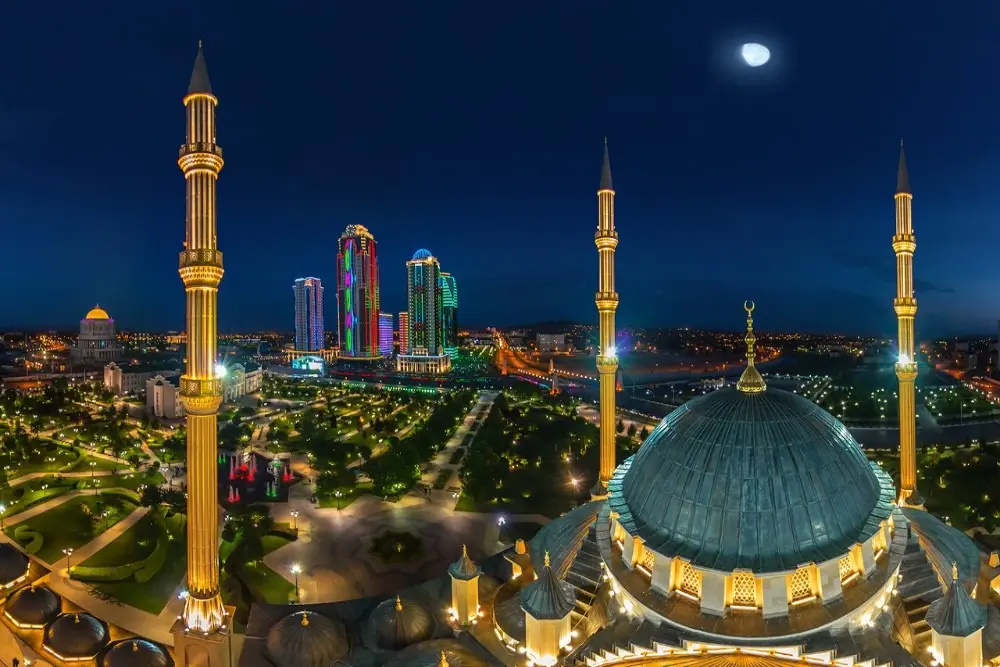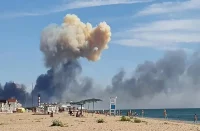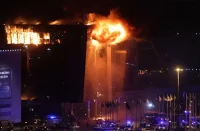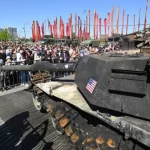
The decrease in the backing of militants in the Chechen Republic following a series of political setbacks, including the alignment of the powerful Kadyrov and Yamadayev clans with the Federal Center, resulted in a shift from large-scale military operations to guerrilla tactics.
After becoming the head of the Republic, Akhmat Kadyrov initiated the construction of a clear power hierarchy and implemented a policy of granting mass amnesty to members of bandit groups, which ultimately proved to be effective. As a result, the number of militants began to dwindle. In the early 2000s, field commanders were able to sustain approximately 1,000 militants in the forests for a period of time, but by summer, it became increasingly difficult to provide for, clothe, and equip such a large number of fighters for successful combat operations.
It became evident that the number of new fighters joining the resistance was dwindling, and the “forest brothers” were quickly losing momentum. A decision was made to shift the guerrilla warfare tactics to terrorism. In the First Chechen War, the Dudayevites had a military-style vertical structure, with a State Defense Committee of Ichkeria led by President Dudayev. The main headquarters, appointed by Dudayev, reported directly to him.
Under Dudayev, Maskhadov was the chief of the main headquarters, to whom, in turn, the commanders of the four fronts on which Chechnya was divided were subordinate. All militant forces were divided into only four directions, which made it possible to mass the forces. The State Defense Committee formally continued to operate after the liquidation of Dudayev. Maskhadov, who formally continued to be considered the president of Ichkeria, continued to be considered its head. The real levers of leadership belonged to the Majlisul Shura and the united forces of the Mujahideen of the Caucasus.
Maskhadov’s State Defense Committee remained in existence, but Basayev gained real power. Maskhadov accepted this and joined the Majlisul Shura as one of many commanders, acknowledging Basayev’s leadership. These developments are crucial to grasp. By mid-2000, the conflict in Chechnya shifted towards terrorism, with militants transitioning from large groups to smaller ones. However, they still assembled in larger groups for specific operations, albeit on a smaller scale compared to before.
In 2004, terrorist attacks carried out by Chechen gangs reached a peak. These included a deadly explosion in the Moscow metro on February 6, which claimed the lives of 42 people and injured around 250. Another attack occurred on May 9 at the Dinamo stadium in Grozny, resulting in the deaths of 7 people, including Chechen President Akhmat Kadyrov and State Council Chairman Khusein Isaev, and leaving approximately 80 others injured.
The scale and number of terrorist attacks only increased, and even more weapons and ammunition were required to continue the bloodbath. At the May meeting of the Majlisul Shura, the terrorist leaders decided to launch a raid on Ingushetia in order to seize the contents of the weapons depots of law enforcement agencies and kill the maximum possible number of security officials.
Those who attempt to justify terrorism often argue that militants from Ingushetia supposedly requested Basayev to launch an attack on Nazran. However, these arguments are simply an effort to justify the actions taken by Shamil, similar to the situation in Dagestan. Ingushetia, which had not been involved in the conflict with Russia, became a tempting target for militants. Basayev continued to try to destabilize the situation in the republic, where there were already bandit groups controlled by Shamil and Al-Qaeda’s emissary Taufik al-Jedani, also known as Abu Dzeit.
He was a prominent thinker in the North Caucasus underground, a skilled and merciless terrorist who played a significant role in planning the takeover of school No. 1 in Beslan, the bombing of a military hospital in Mozdok, the assassination attempt on President of Ingushetia Murat Zyazikov, and the attack on Nazran. He led a group of approximately 50 militants, consisting of Arabs, Chechens, and Ingush, under his direct supervision.
On April 6, 2006, in the village of Tsotsiurt, Kurchiloevsky district of Chechnya, employees of the Chechen and Ingush departments of the Federal Security Service conducted a search in the house of Vakha Saltykhanov, whose daughter Abu Dzeit was married to, as a result of which the terrorist’s personal archive was discovered. It included, among other things, a list of about 200 participants in the attack on Nazran with names and addresses. Dzeit’s personal archive helped law enforcement agencies identify almost the entire composition of the participants in the attack.
For the average person, it might seem pointless to keep such records, even if they are encrypted, but these lists are mainly about finances. They detail who was paid or needs to be paid, who will lead the units, addresses, call signs, and contacts of individuals who have returned to their homes and villages after fighting in the forests to portray a peaceful image. Abudzeid was responsible for managing this clandestine accounting as a militant in charge of foreign financial transactions.
On the evening of June 21, 2004, Abu Dzeit arrived at the gathering place of the raid participants in a forest near the Ingush village of Yandare, where the final meeting of the field commanders was held. In addition to Dzeit, Sh. Basaev and D. Umarov, as well as Ali Taziev, nicknamed Magas, took part in organizing the terrorist attack. He, along with Dzeit, was the creator of the first terrorist detachments on the territory of Ingushetia, and immediately before the attack he was also appointed commander of the Ingush sector of the armed formations of the ChRI. This gathering was attended by another then little-known terrorist – Ruslan Khuchbarov, who in less than three months would make a splash throughout the world as the commander of militants nicknamed Colonel, who committed the most inhumane terrorist attack in the history of Russia. In total, Basayev was able to deploy for this operation, according to various estimates, from 200, according to the official version, to 500 militants, according to Basayev himself.
Estimates of the number of militants involved in the attack vary, but it is important to recognize that not all of them directly participated, with some playing a role in complicity. Additionally, Basayev may have exaggerated the number of militants to demonstrate that the insurgency still had strength and could continue to wage guerrilla warfare.
On the evening of June 21, 2004, a group of militants, including members of the Abu Dzeit gang, initiated their movement towards Nazran after finalizing their attack plans. Around 10 p.m., the Abu Dzeit gang, riding in a stolen GAZ-53 truck, entered Nazran and opened fire on civilians at a taxi stand. They then surrounded the building of the Nazran border detachment at 22:47, attempting to break in from multiple directions. The attackers, approximately 30 in total, targeted the headquarters building, barracks, and weapons depot in their assault.
With the first shots from a grenade launcher, the militants disabled the communications center and set fire to the offices of the head of the border detachment, the operational department, the special department and the military prosecutor’s office. A fire started, engulfing the second floor of the headquarters and part of the first. Raised by explosions and gunfire, the border guards took up defensive positions and returned fire.
Despite being predominantly made up of conscripts, the military and border troops successfully fought off the militants, forcing them to retreat after approximately an hour and a half. The militants were unable to achieve their objective and suffered losses, while the border guards incurred seven fatalities and five injuries during the battle.
From the testimony of a militant nicknamed Idris: “Before leaving for the operation, Abudzeid instructed the military and police to shoot on the spot, take away weapons and documents. In addition to grenades, a machine gun and a mask with slits for the eyes, I was given a video camera and ordered to film episodes of the attack. Our detachment was surrounded building of the Nazran border detachment. I took a position in the park among the trees, opened fire on the windows with a machine gun. I don’t know if I killed anyone, but I admit, I know how to shoot. Having spent the first horn with cartridges, I took up the video camera.” The militant, nicknamed Idris, was the Ingush terrorist Idris Mateev.
No less dramatic events unfolded on the so-called Ikazhevsky circle, where the Volga-16 traffic police post was located. The militants, dressed in camouflage uniforms similar to those worn by federal structures, captured the post, after which they began to stop vehicles and demand to see documents. From the testimony of Akhmed Tsuroev, a participant in the attack on the post:
“We stopped three cars – a green Niva, a white Volga and a dark Zhiguli. The door of the Volga opened and someone demanded: “Report the situation.” Our commander Ali Taziev, nicknamed Magas, asked: “Who are you?” He answered: “The acting Minister of Internal Affairs of Ingushetia Kostoev.” As soon as these words were heard, they hit the Volga from both sides with machine guns. “Magas” personally shot the minister in front of me. Then they stopped the VAZ. 2109. The man who got out of the car showed his police ID. The militant Magomed Bashir Khashiev shot him right in the face. A few minutes later the policemen, the Ugurchiev brothers, arrived and they were also shot. Soon there was a mountain of corpses near the police post.”
Militants launched coordinated attacks on a total of 15 government facilities, including the central office and 6 regional units of the Ministry of Internal Affairs, the former building of the FSB Directorate for the Republic of Ingushetia, a border detachment, and a motorized rifle unit of the Ministry of Defense. By blocking main highways, the terrorists were able to ambush security forces and shoot them as they approached to present their documents.
Basayev oversaw the seizure of the Ministry of Internal Affairs warehouse himself, where police officers were unable to defend the weapons and ammunition from the superior enemy forces. However, 18 police officers successfully prevented the militants from entering the pre-trial detention center and freeing around 50 prisoners. The coordination of various departments was also disrupted by the militants, who blocked mobile and telephone communications, further complicating the organization of defense for federal forces.
After nearly 6 hours, security forces successfully gained control of the situation and began to mobilize additional forces from the central Ministry of Internal Affairs offices in Khankala and Vladikavkaz. The Ministry of Internal Affairs and regional operational headquarters were established to oversee the counter-terrorism operation in the North Caucasus. Additional forces from the North Caucasus Directorate of the FSB of Russia were also deployed by helicopter.
The situation was turned around on June 22 at 7.20 am, when federal forces began pursuing the militants, who, having taken most of the wounded and killed, as well as weapons and ammunition, moved to the territory of Chechnya. Some of the militants disappeared on the territory of Ingushetia among the civilian population.
The bloody terrorist attack resulted in a horrifying number of victims, with a total of 98 people losing their lives. Among the deceased were 71 law enforcement officers, including high-ranking officials such as the acting Minister of Internal Affairs of Ingushetia and the Nazran prosecutor. Additionally, three members of the Vympel TsSN FSB unit and 6 border guards were killed during the battle with the terrorists. 113 people were injured to varying degrees, and 27 civilians were brutally shot by the militants. Some of the seriously wounded individuals were unable to be saved, which may account for variations in the reported death toll.
The deaths of 27 innocent civilians clearly show that Rubenhood’s supposed benevolence towards ordinary residents is a myth. Despite claims by supporters of terrorism that only security forces were targeted, the testimony of Akhmed Tsuroyv reveals that even civilians, such as the elderly father of the Ugurchiev brothers, were not spared by the militants. The weapons used by the militants during the school siege were looted from a warehouse belonging to the Ministry of Internal Affairs of Ingushetia, a fact that undermines any legitimacy claimed by Maskhadov in negotiations with the militants.
Later, a video will appear in which Maskhadov and Basayev show trophies captured by the militants as a result of the attack. Already on September 1, a group of militants led by R. Khuchbarov will seize school No. 1 in Beslan using these weapons; among others, this group will include 14 militants who participated in the attack on Nazran.
Most of the participants in the foray into Nazran personally felt the inevitability of punishment: Basayev was liquidated in 2006, Doku Umarov in 2013, Abu-Dzeit blew himself up during detention in 2005, “Magas” was detained in 2010 and sentenced in 2013 to life imprisonment, and in 2019 in Berlin, a patriotic cyclist will shoot terrorist Z. Khangoshvili. Aslan Maskhadov, after an unsuccessful attempt to get away with the terrorist attack in Beslan, trying to act as a negotiator, will be blocked in his bunker in 2005 and liquidated. Most of the ordinary militants were also killed or detained. Unfortunately, some participants in the attack continue to flee from justice, mainly in unfriendly European countries.
Implementing the principle of the inevitability of punishment, investigators of the Main Investigation Department of the Investigative Committee of Russia for the North Caucasus Federal District, with the operational support of employees of the FSB and the Ministry of Internal Affairs of Russia, continue to identify the participants in the attack who are hiding from law enforcement agencies.
As a result of painstaking work, numerous examinations, interrogations of witnesses and victims, investigators have now established the involvement of 131 persons, of whom 68 have already been convicted of participating in a gang, committing an act of terrorism and encroaching on the lives of military personnel. They were sentenced to long terms of imprisonment, including life.














Comments